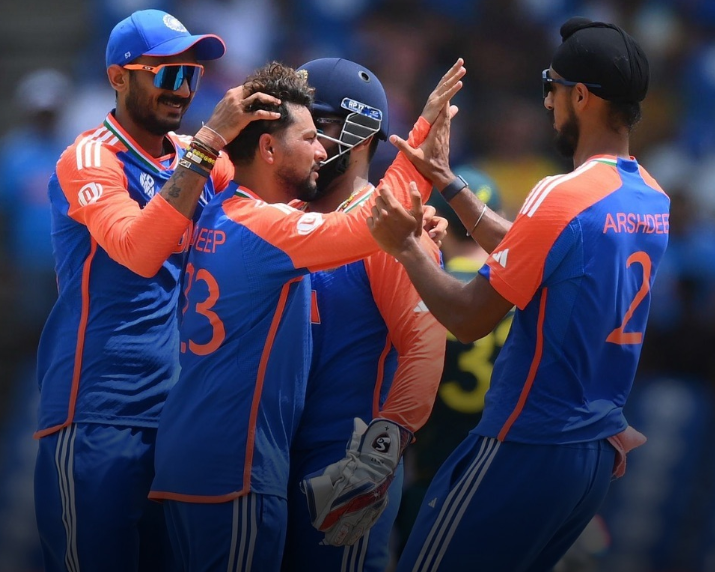Australia vs. Afghanistan Shocking Exit: What Led to Australia’s Unbelievable Downfall in the T20 World Cup? – They have had their fair share of controversies and nail-biting matches, or simply the so-called ‘Hockey World Cup moments’ in the T20 World Cup.
This year’s edition of the competition has not disappointed, with upsets and shockers cropping up all over the place. But amongst all the major and minor shocks, the most striking was Australia’s early elimination from the tournament. This piece discusses the main events of the Australia’s exit, after analyzing the final match, the most outstanding individual and team efforts, additional factors that led to their elimination, and overall Australian cricket.

The Decisive Match: Australia vs. South Africa
Due to the loss of Australia in the T20 world cup fixtures, the final group stage match against South Africa. Each side knew that a place in the semi-final was at play, making the match an intense affair. With such a legacy, the pressure was on and Australian cricket team did not disappoint as it began to dominate the format.
ALSO READ: “India vs Pakistan T20 World Cup: Unbelievable Victory in a High-Stakes Thriller!”
ALSO READ: Apple Drops iPhone 15 Pro and 15 Pro Max Prices in India – Here’s Why!
ALSO READ: “Sonakshi Sinha’s Grand Wedding: All the Glamorous Details You Need to Know!”
Match Overview
- Date: June 20, 2024
- Venue: The specific stadiums that are involved include Melbourne Cricket Ground (MCG) of Melbourne.
- Result: South Africa secured victory by six wickets
First Innings: Australia’s Batting Challenges
In the match between Australia and Sri Lanka, Australia decided to bat first after they won the toss with the clear intention to post a respectable total. Nonetheless, Kagiso Rabada & Anrich Nortje had South Africa’s bowlers in fine fettle, meaning Australian batsmen could not gain the upper hand.
Top Performers:
David Warner: 45 of 38 balls.
Glenn Maxwell: 37 out of 25 balls

However, these strategies did not work as planned, with the Australian batting order not being able to build worthwhile stands. Contribution was limited due to regular wickets, which kept recurring throughout the match and they were able to post only 157 for 8 in 20 overs. Such bowling statistics as 3/24 by Rabada and 2/30 by Nortje were helpful in restricting Australians.
Second Innings: South Africa’s Steady Chase
Set a target of 158 runs for the win, South African openers Quinton de Kock and Reeza Hendricks were stable. The fast bowlers from the Australian side, including Mitchell Starc and Adam Zampa, attempted to build some sort of pressure on the South Africans, but the batsmen held their nerve.
Top Performers:
Quinton de Kock: 61 off 45 balls
Aiden Markram: 43* off 28 balls
De Kock made a fiery half-century, and Markram brought solidity to the end, chasing the target with six wickets remaining and two overs unused. This was the last fight of the Australians, and as we can see, it was not very successful for the team.
Circumstances That Led to Early Exit in Australia
These are the reasons why Australia failed to progress beyond the first round of the T20 World Cup. Knowledge of these elements helps to comprehend the issues the team encounters and the ways for its enhancement.
1. Inconsistent Batting Performances
One aspect of Australia for which they remained quite unpredictable was their batting order. It is sometimes difficult to construct substantial, valued wary partnerships or post competitive totals, while individual players sometimes show glimpses of brilliance. Prominent batsmen such as Aaron Finch, Steve Smith, and Marcus Stoinis failed to get going, which added to the team’s burden for the middle and bottom half.
2. Bowling Inconsistencies
Generally a point of strength for the Australian side, the bowling failed to come up to par. Mitchell Starc, Pat Cummins, and Adam Zampa were visible throughout the tournament but could not deliver a consistent line of bowling, thus not being able to put pressure on the rival teams. In the most important match in the competition against South Africa, the bowlers failed to take the field and ensure that the team defended a below par score, thus exposing their lack of nerve.
3. Fielding Errors
While Australian cricket has not generally been noted for substandard fielding, their performance in this tournament was average at best. Aspects such as dropped catches and misfields at vital stages turned out to be really expensive as the opponents were able to seize the opportunity and dominate the game. These failures in the field added to the many problems that the team had to face.

The study has implications for the broader context of Australian cricket and for the management of the national cricket team.
Australia’s premature elimination from the latest T20 World Cup has great repercussions for the team as well as the Australian cricketing system. It requires looking inward and questioning tactics and people involved in the operational cycle.
ectors and team management cannot avoid re-assessing the selected squad and the criteria used in selection. Mystery of selecting the core of the team with experienced players who might be out of form and choosing new young talents in form is challenging. Therefore, the presence of prospective talents from domestic cricket can also be a factor to apply to the team to bring new energy.
Coaching and Support Staff
Duties of the coaching team, together with the head trainer and all the assistance, will also be investigated. In this case, evaluating their tactics, training approach, effectiveness of leadership, and other motivational and disciplinary measures for the players will be vital for the necessary changes to be made. Basically, the coaches have to prepare their players for all the changing trends of the T20 match so that the players should be in best stead when facing different high-intensity situations akin to those that would be encountered in the World Cup.
Psychological Strength & Stress Coping
Cricket is one of the greatest examples how much mental exercise is also involved with physical action. That is the reason why the ability to perform when under pressure, particularly during tournament sessions, is unique. Australia should seek to develop mental strength, mental toughness and psychology for some understanding of the players as they go through stress throughout the game. Developing self-competencies can help boost staff performance in pressure leadership circumstances and bolster morale.
Looking Ahead: Returning to Where Life Began
The Australian team’s failure to proceed to the second round of the T20 World Cup is a disappointment but equally a chance to restart from square one. Players should focus on improving any mistake made and adapting to the change by regrouping in future tournaments.
Talent Development
Building talent at the grassroots level and in domestic cricket is another recommendation that needs to be made. Giving young players a chance and ensuring that they are provided with the best conditions possible to develop skills necessary for international play can guarantee the country a strong talent pool.

Embracing Modern T20 Strategies
One cannot say that there has been a single unchangeable set of approaches to T20 cricket because strategies change frequently. Hence, Australia requires new strategies as part of its ability to challenge the conventions of batting, bowling and fielding. Gaining knowledge of how winning strategies are implemented offers considerable information.
Building a Balanced Team
When it comes to manpower, there must be harmony in that particular team. This involves having players with prior knowledge in the game, young talents, players familiar with specific responsibilities, and players who flourish in high-stakes contexts. These are entertainment factors that, if well managed, can improve the performance of the team through flexibility, especially in batting, bowling and fielding options.
The T20 World Cup elimination for Australia was a major upset, not only for the team but also for the supporters. Nevertheless, it proved helpful in learning. Australia can look ahead to the next tournaments in order to come back stronger by solving the problems mentioned, providing changes where appropriate, and trying to maintain a strong focus on both the mental and physical aspects of the game. STRATEGIC DIRECTION There can only be some soul-searching, more changes and hard work to get the team back to its previous form of dominating in international T20 cricket.











